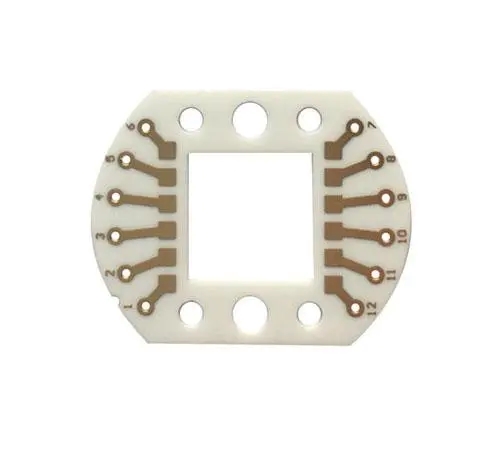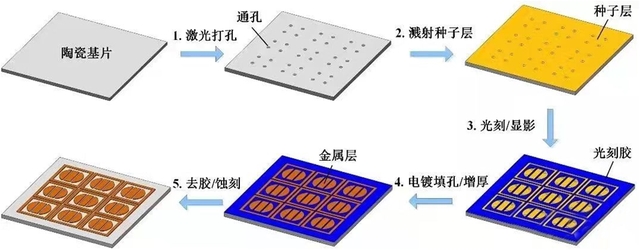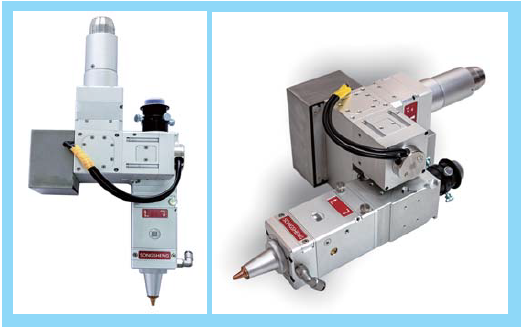Application of Laser Cutting and Drilling Processes in Ceramic Circuit Board Production
With the ongoing advancement of 5G infrastructure, industrial sectors such as precision microelectronics and aerospace/shipbuilding have experienced significant growth, all of which involve applications of ceramic substrates. Among these, ceramic PCB substrates are gaining increasing adoption due to their superior performance characteristics.
Ceramic substrates serve as fundamental materials for high-power electronic circuit architecture and interconnection technologies, featuring dense microstructures but inherent brittleness. Conventional machining methods introduce mechanical stress during processing - a critical drawback that frequently causes fracturing in ultra-thin ceramic sheets.

Ceramic Substrate Finished Product Diagram
Due to the small size and high density of electronic and semiconductor components, laser drilling requires high precision and speed. Depending on specific application requirements, the micro via diameter ranges from 0.05 to 0.2mm. Currently, ceramic substrates are generally processed using lasers for drilling, with pulsed lasers or quasi-continuous lasers (fiber lasers) typically employed for ceramic laser drilling. The laser spot diameter is usually ≤0.05mm.
By controlling the defocusing amount, through-holes of different diameters can be achieved according to the thickness of the ceramic substrate. For through-holes with diameters smaller than 0.15mm, drilling can be accomplished by controlling the defocusing amount.

Ceramic Substrate Process Flow Diagram
Currently, there are two primary methods for cutting ceramic circuit boards: waterjet cutting and laser cutting, with fiber lasers being the predominant choice in the market for laser cutting applications. Fiber laser cutting of ceramic circuit boards offers the following advantages:
(1) High precision, fast speed, narrow kerf width, small heat-affected zone, and smooth, burr-free cutting edges.
(2) The laser cutting head does not contact the material surface, preventing workpiece scratches.
(3) Narrow kerf width and minimal heat-affected zone result in extremely localized deformation and no mechanical distortion.
(4) Excellent processing flexibility, enabling the cutting of any desired shape, including pipes and other profiled materials.

SongSheng Optoelectronics has developed the QCW1064 high-speed rotary precision micro-hole processing cutting head to meet precision cutting and drilling requirements. This cutting head is a precision fiber (λ=1064nm) cutting head featuring a multi-element collimating and focusing lens assembly that delivers a small focused spot with high accuracy. When combined with XY galvanometer rotation and fiber lasers, it enables micro-aperture cutting. The optimized mechanical design and precision adjustment mechanisms, along with complete sealing performance, water cooling, and coaxial gas assist, allow the laser cutting head to operate stably at higher power levels. This product is compatible with coaxial imaging.
It can drill micro-holes with diameters of Φ0.1-0.5mm in ceramic substrates, aluminum plates, copper plates, and stainless steel plates under 1mm thickness. With coaxial gas assist, the cutting achieves excellent roundness and smooth edges.
Under the trends of thinning and miniaturization, traditional cutting methods can no longer meet the requirements due to insufficient precision. As a non-contact processing tool, laser technology offers significant advantages over conventional cutting methods and plays a crucial role in the processing of ceramic substrate PCBs.
Contact: Mr.Xiao
Phone: +86-13385280662
E-mail: market001@whlaser.cn
Add: Room 02, Floor 5, Building 9, Gezhouba Sun City, No. 40, Gaoxin 4th Road, Donghu New Technology Development Zone, Wuhan